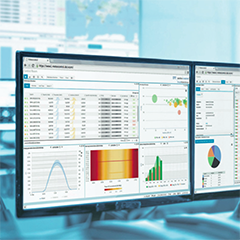Shaping the future of professional PV monitoring
At PES, we thought it was time to discuss PV monitoring with Stefan Rensberg Head of Product Management at meteocontrol. Stefan has seen a big change in this area and is absolutely confident of its importance in the PV plant of today and tomorrow. Things have come a long way over the last 15 years and he is sure that data handling is the key for the future. Read on to find out more…
PES: Hello Stefan, welcome back to PES. Could you begin by telling us a little bit about yourself.
Stefan Rensberg: I have been with meteocontrol in Augsburg, Germany for over 15 years and work there as head of product management, with a great team.
As a product engineer, I started with the development of meteocontrol’s first data logger WEB’log and the Safer’Sun monitoring portal.
I’d describe myself as being absolutely passionate about photovoltaics in general and especially about the possibilities that photovoltaic monitoring and data analytics offer. What stimulates me is being surrounded by people who create new ideas and innovations and share the vision of a better, cleaner future. Climate change really is a topic for every single day.
PES: We would like to know how you define photovoltaic monitoring?
SR: Building a solar plant is just the beginning, they also need to be operated, monitored, and maintained. Commercial PV systems regularly use a subscription component as a monitoring service as a part of the package. Monitoring systems are able to provide an abundance of information about the performance of a solar system. Additional sensors can assist in monitoring external conditions.
In a nutshell, photovoltaic monitoring makes it possible to monitor all of the PV plant components, in order to quickly detect malfunctions and to report them to the installer and the plant operator.
In the short term, PV monitoring helps you to detect when some element of the system isn’t working properly, so you can correct the problem as soon as possible. When your monitoring system has been collecting data for several years, you will start to observe trends regarding solar output and efficiency. This enables you to use that information in order to optimize the system’s overall performance, including the maintenance schedule.
Today’s optimal monitoring systems consist of a manufacturer-independent monitoring device like meteocontrol’s blue’Log® and a professional, independent monitoring portal like the VCOM Cloud. Last but not least, the monitoring portal itself should be equipped with an open interface for any source of external data.
Shaping the future of professional PV monitoring
At PES, we thought it was time to discuss PV monitoring with Stefan Rensberg Head of Product Management at meteocontrol. Stefan has seen a big change in this area and is absolutely confident of its importance in the PV plant of today and tomorrow. Things have come a long way over the last 15 years and he is sure that data handling is the key for the future. Read on to find out more…
PES: Hello Stefan, welcome back to PES. Could you begin by telling us a little bit about yourself.
Stefan Rensberg: I have been with meteocontrol in Augsburg, Germany for over 15 years and work there as head of product management, with a great team.
As a product engineer, I started with the development of meteocontrol’s first data logger WEB’log and the Safer’Sun monitoring portal.
I’d describe myself as being absolutely passionate about photovoltaics in general and especially about the possibilities that photovoltaic monitoring and data analytics offer. What stimulates me is being surrounded by people who create new ideas and innovations and share the vision of a better, cleaner future. Climate change really is a topic for every single day.
PES: We would like to know how you define photovoltaic monitoring?
SR: Building a solar plant is just the beginning, they also need to be operated, monitored, and maintained. Commercial PV systems regularly use a subscription component as a monitoring service as a part of the package. Monitoring systems are able to provide an abundance of information about the performance of a solar system. Additional sensors can assist in monitoring external conditions.
In a nutshell, photovoltaic monitoring makes it possible to monitor all of the PV plant components, in order to quickly detect malfunctions and to report them to the installer and the plant operator.
In the short term, PV monitoring helps you to detect when some element of the system isn’t working properly, so you can correct the problem as soon as possible. When your monitoring system has been collecting data for several years, you will start to observe trends regarding solar output and efficiency. This enables you to use that information in order to optimize the system’s overall performance, including the maintenance schedule.
Today’s optimal monitoring systems consist of a manufacturer-independent monitoring device like meteocontrol’s blue’Log® and a professional, independent monitoring portal like the VCOM Cloud. Last but not least, the monitoring portal itself should be equipped with an open interface for any source of external data.
To read the full content,
please download the PDF below.






























